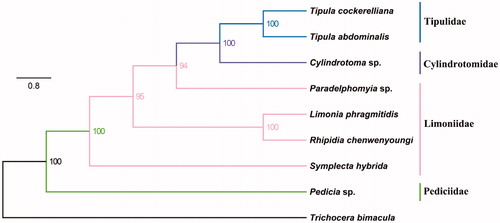Abstract
The crane fly Limonia phragmitidis belongs to family Limoniidae. The mitogenome of L. phragmitidis was sequenced, the new representative of the mitogenome of the family Limoniidae. The nearly complete mitogenome is 16,020 bp totally, consisting of 13 protein-coding genes, 2 rRNAs, and 22 transfer RNAs. All genes have similar locations and strands with that of other published species of Limoniidae. The nucleotide composition biases toward A and T, which together made up 75.5%of the entirety. Bayesian inference analysis strongly supported the monophyly of Tipuloidea. It suggested that the phylogenetic relationship within Tipuloidea, Pediciidae + (Limoniidae + (Tipulidae + Cylindrotomidae)).
Introduction
Superfamily Tipuloidea (Tipulomorpha sensu stricto or Tipulidae sensu lato) is one of the highly diversified groups in Diptera with 15,485 recognized species in 703 genera and subgenera (Yeates and Wiegmann Citation2005; de Jong et al. Citation2008; Oosterbroek Citation2018). The historical arguments focus on the Limoniidae that reflects paraphyletic and phylogenetic position (Oosterbroek and Theowald Citation1991; Ribeiro Citation2008; Petersen et al. Citation2010). The mitochondrial (mt) genomes have been used widely for phylogenetic studies of insects (Cameron Citation2014). To date, there are eight complete or nearly complete Tipuloidea mitochondrial genome sequences in GenBank, among them three species belong to Limoniidae. However, Limoniidae (10,778 species and subspecies) is the largest family in Tipuloidea (Oosterbroek Citation2018). Hence, the more limoniids need sequencing to clarify the phylogeny of Tipuloidea. This paper adds new sequencing data for the family Limoniidae.
The specimens of Limonia phragmitidis (Diptera: Limoniidae) used for this study were deposited in the Entomological Museum of China Agricultural University (CAU). The total genomic DNA was extracted from the whole body (except head) of the specimen using the QIAamp DNA Blood Mini Kit (Qiagen, Germany) and stored at −20 °C until needed. The mitogenome was amplified and sequenced as described in our previous study (Wang et al. Citation2016). The nearly complete mitogenome of L. phragmitidis is 16,020 bp. It encoded 13 PCGs, 21 tRNA genes and 2 rRNA genes and the control region could not be sequenced in this study and were similar with related reports before (Zhang et al. Citation2016; Wang et al. Citation2016;). All genes have the similar locations and strands with that of other published Limoniidae species. The nucleotide composition of the mitogenome was biased toward A and T, with 75.5% of A + T content (A = 37.8%, T = 37.7%, G = 10.3%, C = 14.2%). The A + T content of PCGs, tRNAs, and rRNAs is 75.5%, 77.0%, and 79.8%, respectively. The total length of all 13 PCGs of L. phragmitidis is 16,020 bp. Four PCGs (NAD2, NAD3, ATP8 and NAD6) initiated with ATT codons, and seven PCGs (COX2, COX3, ATP6, NAD1, NAD4L, NAD4 and CYTB) initiated with ATG codons, COX1 and NAD5 initiated with TCG and GTG as a start codon respectively.
Phylogenetic analysis was performed based on the nucleotide sequences of 13 PCGs from 9 Diptera species. Bayesian (BI) analysis generated the phylogenetic tree topologies based on the PCGs matrices (). According to the phylogenetic result, it showed that the monophyletic Tipuloidea was assigned to be the sister group to the clade of Trichoceridae. The Limoniidae is the sister group to the clade of Tipulidae + Cylindrotomidae, and Pediciidae is basal clade of Tipuloidea. The phylogenetic relationship within Tipuloidea is very clear: Pediciidae + (Limoniidae + (Tipulidae + Cylindrotomidae)). The phylogenetic relationship within Tipuloidea was also supported by the previous study (Petersen et al. Citation2010; Zhang et al. Citation2016).
Disclosure statement
No potential conflict of interest was reported by the authors.
Additional information
Funding
References
- Cameron SL. 2014. Insect mitochondrial genomics: implications for evolution and phylogeny. Ann Rev Entomol. 59:95–117.
- De Jong H, Oosterbroek P, Gelhaus J, Reusch H, Young C. 2008. Global diversity of craneflies (Insecta, Diptera: Tipuloidea or Tipulidae sensu lato) in freshwater. Hydrobiologia. 595:457–467.
- Oosterbroek P. 2018. Catalogue of the Craneflies of the World, (Diptera, Tipuloidea, Pediciidae, Limoniidae, Cylindrotomidae, Tipulidae). [accessed 2018 September 9] http://c-cw.naturalis.nl/.
- Oosterbroek P, Theowald B. 1991. Phylogeny of the Tipuloidea based on characters of larvae and pupae (Diptera, Nematocera) with an index to the literature except Tipulidae. Tijdshcrift Voor Entomologie. 134:211–267.
- Petersen MJ, Bertone MA, Wiegmann BM, Courtney GW. 2010. Phylogenetic synthesis of morphological and molecular data reveals new insights into the higher-level classification of Tipuloidea (Diptera). System Entomol. 35:526–545.
- Ribeiro GC. 2008. Phylogeny of the Limnophilinae (Limoniidae) and early evolution of the Tipulomorpha (Diptera). Invertebr System. 22:627–694.
- Wang Y, Liu X, Yang D. 2016. The complete mitochondrial genome of a fishfly, Dysmicohermes ingens (Chandler) (Megaloptera: Corydalidae: Chauliodinae). Mitochondrial DNA Part A. 27:1092.
- Yeates DK, Wiegmann BM. 2005. In: Yeates DK, Wiegmann BM, editors. The Evolutionary Biology of Flies. New York, New York: Columbia University Press.
- Zhang X, Kang Z, Mao M, Li X, Cameron SL, Herman DJ, Wang M, Yang D. 2016. Comparative mt genomics of the Tipuloidea (Diptera: Nematocera: Tipulomorpha) and its implications for the phylogeny of the Tipulomorpha. PLoS One. 11:e0158167.

